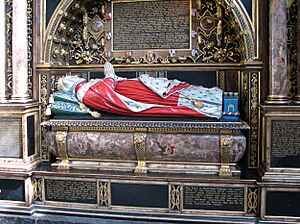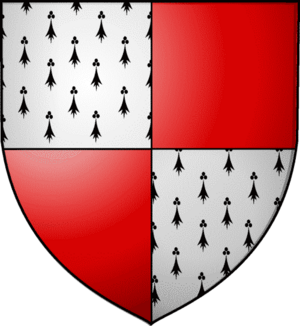Anne Seymour, Duchess of Somerset facts for kids
Quick facts for kids
Anne Seymour
|
|
|---|---|
| Duchess of Somerset | |
 |
|
| Born | c. 1510 |
| Died | 16 April 1587 Hanworth Palace, Middlesex |
| Buried | Westminster Abbey, London |
| Spouse(s) | Edward Seymour, 1st Duke of Somerset Francis Newdigate |
| Issue | Edward Seymour Edward Seymour, 1st Earl of Hertford Anne Dudley, Countess of Warwick Lady Jane Seymour Mary Seymour Elizabeth Seymour Lord Henry Seymour |
| Father | Sir Edward Stanhope |
| Mother | Elizabeth Bourchier |
Anne Seymour, Duchess of Somerset (born Anne Stanhope; around 1510 – 16 April 1587) was an important woman in England during the time of King Edward VI. She was the second wife of Edward Seymour, 1st Duke of Somerset. He was the Lord Protector, meaning he ruled England for his nephew, King Edward VI, who was too young to rule himself. For a short time, Anne was one of the most powerful women in the country.
Contents
Family Background
Anne Stanhope was born around 1510. She was the only child of Sir Edward Stanhope and Elizabeth Bourchier. Through her mother, Anne was a descendant of Thomas of Woodstock, who was the youngest son of King Edward III of England. This meant she had a connection to the royal family.
Anne was known for being very smart and determined. Some people found her personality to be very strong, even a bit proud.
First Marriage
Anne Stanhope married Sir Edward Seymour sometime before 1535. Edward Seymour was the older brother of Jane Seymour, who became the third wife of King Henry VIII.
When King Henry VIII married Jane Seymour in 1536, Edward Seymour became a Viscount. Later, after his nephew Edward was born, he became the Earl of Hertford. In 1547, he became a Duke, which made Anne the Duchess of Somerset.
Her Children
Anne and Edward Seymour had ten children together:
- Edward Seymour, Viscount Beauchamp of Hache (1537–1539)
- Edward Seymour, 1st Earl of Hertford (1539–1621)
- Lord Henry Seymour (born 1540)
- Lady Anne Seymour (1538–1588)
- Lady Margaret Seymour (born 1540)
- Lady Jane Seymour (1541–1561)
- Lady Catherine Seymour (1548–1625)
- Lord Edward Seymour (1548–1574)
- Lady Mary Seymour (born 1552, died 1620)
- Lady Elizabeth Seymour (1552–1602)
Queen Jane Seymour was a godparent to Anne's first child. This was a special honor, showing the close connection between the families.
Life at Court
Anne Seymour was at the wedding of King Henry VIII and Catherine Parr in 1543. After King Henry VIII died, Anne's husband, Edward Seymour, became the Lord Protector. This meant he had almost as much power as a king.
Because of her husband's high position, the Duchess of Somerset believed she should be the most important lady in England. She even thought she should have a higher rank than Catherine Parr, who was the late King's widow. This was because Catherine Parr had married Edward Seymour's younger brother, Thomas Seymour.
The Duchess felt that Catherine Parr lost her special status by marrying someone lower in rank than the Lord Protector. Anne refused to carry Catherine's long dress (train) and sometimes tried to push her out of the leading position at court events. Anne was heard saying, "If master admiral (Thomas Seymour) teach his wife no better manners, I am she that will." Catherine Parr, in turn, called Anne "that Hell."
Catherine Parr eventually won this argument. She used a law that clearly stated she had a higher rank than all other ladies in the kingdom. In fact, Anne Seymour was ranked after Catherine Parr, King Henry's daughters Mary and Elizabeth, and Henry's former wife, Anne of Cleves. Anne was described as a very strong-willed woman. Her actions sometimes made her husband less popular.
In 1549, her husband, the Lord Protector, lost his power. He and Anne were sent to the Tower of London. Anne was released after a short time. Her husband was released in January 1550. Anne then visited the home of the new powerful leader, John Dudley, Earl of Warwick. Soon after, her husband was allowed to join the King's council again. The Duchess of Somerset and the Countess of Warwick then arranged for their children, Anne Seymour and John Dudley, to marry.
However, in 1551, Edward Seymour was arrested again. He was accused of planning against Warwick, who had become the Duke of Northumberland. Anne and her husband were again sent to the Tower. Edward Seymour was found guilty and was executed in January 1552. Anne remained in the Tower until May 1553. After Queen Mary I became queen, Anne was allowed to choose items from the Dudley family's belongings, which had been taken by the Crown.
Second Marriage
Anne Seymour later married Francis Newdigate. He had worked for her first husband. Not much is known about their life together.
Death and Burial

Anne Seymour died on 16 April 1587, at Hanworth Palace. She was buried in Westminster Abbey in London. You can still see her tomb there today.
Queen Elizabeth I ordered a list to be made of Anne's jewels and money after she died. In her will, Anne left a special locket to her daughter-in-law, Lady Katherine Grey. It had old-style artwork on one side and a rose made of diamonds on the other.
In Fiction
Anne Seymour has appeared in movies and TV shows:
- She was played by Kathleen Byron in the 1953 film Young Bess.
- In the TV series The Tudors, Anne is shown as a woman with many talents.
- She was mentioned in the show Becoming Elizabeth. In one scene, Jane Grey tried to comfort Catherine Parr, who was pregnant, by saying that the Lord Protector's wife had survived many pregnancies. Catherine Parr replied that she thought nothing could kill the Lord Protector's wife.
Sources
- Barrett L. Beer, Northumberland: The Political Career of John Dudley, Earl of Warwick and Duke of Northumberland, 1973, The Kent State University Press; ISBN: 0-87338-140-8
- David Loades: John Dudley, Duke of Northumberland 1504–1553, 1996, Clarendon Press; ISBN: 0-19-820193-1
- Antonia Fraser, The Wives of Henry VIII, Alfred A. Knopf, New York, 1992; ISBN: 0-394-58538-0
- Anthony Martienssen, Queen Katherine Parr, McGraw-Hill Book Co., New York, St. Louis, San Francisco, Düsseldorf, Mexico, 1973; ISBN: 0-07-040610-3


